By Taylor Althouse, Freedom Center for Animal Life-Saving, Client Care Representative
May 20th was National Rescue Dog Day! To celebrate this special howliday, Freedom Center for Animal Life-Saving Client Care Representative, Taylor Althouse, shared a heartwarming rescue story that truly changed her life.
I got the chance to care for Gracie during her temporary stay with us at the beginning of this year. While I get to meet and interact with lots of amazing animals in my position, I genuinely believe Gracie has, by far, had the greatest impact on me.
In January 2022, Humane Pennsylvania’s Berks Campus Shelter Manager Brandea Taylor re-introduced the concept of Pet-Projects. Each member of the Freedom Center for Animal Life-Saving team chose a specific animal to dedicate time to every day, to provide comfort and enrichment during the animal’s stay at the shelter. Our facility had just received a new group of rescued dogs from Louisiana, so I decided to choose one of the new faces that had just flown in.
That’s how I met Gracie (previously called Joni).
After I passed the other wagging tails, I got to the last kennel and saw a trembling, chocolate Lab with the prettiest golden eyes staring back at me. I decided right then that I would do everything in my power to help this special girl.
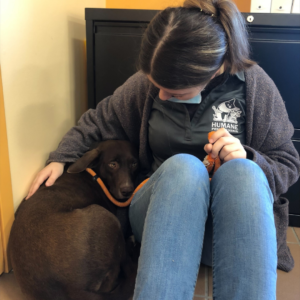 My plan was to spend all my extra time trying to make her comfortable with me and gain her trust. This started with us standing on opposite sides of the kennel — and lots of treats. She slowly became comfortable enough to eat them, but only if I was not looking directly at her.
My plan was to spend all my extra time trying to make her comfortable with me and gain her trust. This started with us standing on opposite sides of the kennel — and lots of treats. She slowly became comfortable enough to eat them, but only if I was not looking directly at her.
This was progress! I took this little leap in stride and upped the ante! I sat on my side of the kennel and offered Gracie small piece of hot dog. Gracie repeatedly looked back and forth, from the hot dog to me and back again. I turned my face away, with my hand still out. And a few seconds later, I felt a small, wet nose push against my hand and take the hot dog. I could not believe it!
Over the next few weeks, Gracie became more and more comfortable with me. I began sitting on her side of the kennel with her and taking her on walks outside. She went from slinking across the ground to standing fully and sniffing around.
Soon, she became so comfortable with me that she began nudging my hand for head rubs and giving me so many kisses that I’m sure my coworkers got tired of me bragging about it. I was just so proud and happy about her progress in such a short amount of time.
Gracie was on the adoption floor for most of her time at the shelter, but everyone who asked about her was disappointed that she was not the typical one-year-old Lab. She was essentially the exact opposite, just shaking in the back of her kennel.
I was still nervous about how she would do when she got her first adoption meet. When the day came, I warned the nice couple about how nervous Gracie was and I gave them her favorite treats to help ease her nerves.
We took Gracie into the play yard, where she immediately went to the corner and hid. The couple kept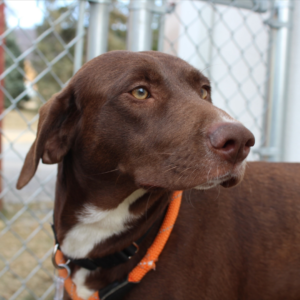 giving Gracie treats and calmly talking to her to coax her out of her shell, and she eventually gave in to their kind attempts.
giving Gracie treats and calmly talking to her to coax her out of her shell, and she eventually gave in to their kind attempts.
As we discussed her progress, Gracie started crouching toward the couple, trying to sniff them. This was a huge moment for everyone involved. Throughout her time at the shelter, she would not voluntarily get close to anyone besides me, and it took what seemed like forever for us to get to that point.
The couple visiting Gracie had brought their dog Leo to meet her. Leo instantly wanted to be her friend, but Gracie sat frozen behind me. Although she was frightened, there were no signs of aggression from either of the dogs. And with the counsel of our Animal Care Coordinator, Katie Litz, the adopters decided to go through with the adoption!
I took the time I had left with Gracie to sit with her and tell her how awesome her new life was going to be. Her true personality was just locked up inside, and I was confident that her new family would help her be her authentic self.
Since Gracie’s adoption in February, we have received the most precious pictures and updates on her progress.
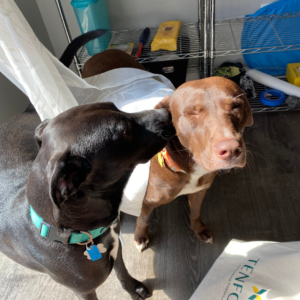 “When we got Gracie, she was incredibly shut down and would run away from us and hide any chance she got. She no longer hides and is often found roaming around, exploring the house while wagging her tail. Even more frequently, she can be found sitting on top of anyone who is willing to give her her favorite neck rubs. She has started giving us face kisses and smiles when she gets to run around outside. She’s such a good dog, and I’m so glad that you all believed in her and in us.” – Bryan and Alicia (Gracie’s adopters)
“When we got Gracie, she was incredibly shut down and would run away from us and hide any chance she got. She no longer hides and is often found roaming around, exploring the house while wagging her tail. Even more frequently, she can be found sitting on top of anyone who is willing to give her her favorite neck rubs. She has started giving us face kisses and smiles when she gets to run around outside. She’s such a good dog, and I’m so glad that you all believed in her and in us.” – Bryan and Alicia (Gracie’s adopters)
Stories like Gracie’s are why we do what we do. These animals leave an unforgettable impact on the people who experience them, and they provide all the motivation we need to continue to provide the care they deserve.
Being able to change a life by giving pets in our care the support they need and helping them find their perfect match is what our jobs (and mission) are all about, and I am so glad I was given the opportunity to help Gracie.
To rescue an animal like Gracie, please visit https://humanepa.org/adoption/.


 owners happen because the pets are microchipped and registered with up-to-date contact information.
owners happen because the pets are microchipped and registered with up-to-date contact information. Each microchip has a unique number, an ID number of sorts, that needs to be registered with the pet owner’s name, address, and phone number. It is important to ensure a chip is registered and information is kept up to date.
Each microchip has a unique number, an ID number of sorts, that needs to be registered with the pet owner’s name, address, and phone number. It is important to ensure a chip is registered and information is kept up to date.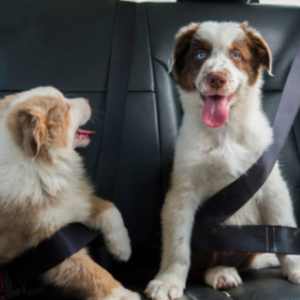 In our area of Pennsylvania, we don’t have to worry too much about natural disasters like hurricanes and tornadoes. However, severe weather here can easily lead to flooding. And no matter where you live, you can be affected by a local water main break or power outages due to high winds and ice storms.
In our area of Pennsylvania, we don’t have to worry too much about natural disasters like hurricanes and tornadoes. However, severe weather here can easily lead to flooding. And no matter where you live, you can be affected by a local water main break or power outages due to high winds and ice storms. leashes, and/or harnesses, and a favorite toy/scent article. Pack a duplicate bag to keep in the car if you travel often with your pet, and be sure to rotate medications so they stay fresh.
leashes, and/or harnesses, and a favorite toy/scent article. Pack a duplicate bag to keep in the car if you travel often with your pet, and be sure to rotate medications so they stay fresh. Humane Pennsylvania is home to the Berks County Animal Response Team (CART), which works directly with the Pennsylvania State Animal Response Team (PSART) and serves as the primary Eastern Pennsylvania large-scale emergency distribution resource for pet food and supplies. We are gearing up to deploy emergency supplies for up to 1,500 animals.
Humane Pennsylvania is home to the Berks County Animal Response Team (CART), which works directly with the Pennsylvania State Animal Response Team (PSART) and serves as the primary Eastern Pennsylvania large-scale emergency distribution resource for pet food and supplies. We are gearing up to deploy emergency supplies for up to 1,500 animals.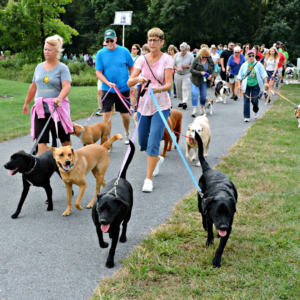 For the last 44 years, Humane Pennsylvania has hosted the
For the last 44 years, Humane Pennsylvania has hosted the  those 10 years, Humane Pennsylvania has also become a leader in animal welfare and has paved the way with innovative approaches and programs, due in part to the funds raised from the Walk.
those 10 years, Humane Pennsylvania has also become a leader in animal welfare and has paved the way with innovative approaches and programs, due in part to the funds raised from the Walk.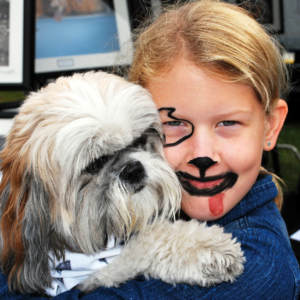 This community-wide, family-friendly event is FREE and open to the public!
This community-wide, family-friendly event is FREE and open to the public!